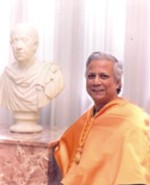|
Perspective From Dhaka and Tehran Sajid Huq
 |
Dhaka University like Tehran University has always been the central hub of political activism. |
So I Tend to like most things Persian - Kiarostami, miniature paintings, khoresht, the excessive use of nuts and saffron in "polow" - and almost all of whatever I have been exposed to - of Persian architecture, arts and literature. I also love how Farsi sounds.
Once, while chatting with a Professor of Islamic History he pointed out to me, how political Islam has had an uneasy relationship with both Iranian and Bangali society. Perhaps.
I suppose the presence of long secular cultures, very productive in the arts and literature, true for both Bengal and Persia, might create problems for certain kinds of Islamisms. Of course, the history of political Islam in any Muslim country is nothing if its not inconsistent and checkered. So it's hard to generalise.
Another interesting analogy between Bangladeshi and Persian societies is the central role Dhaka and Tehran University have played in defining their states' religio-political cultures.
Dhaka University, founded soon after the first Partition of Bengal in 1905, to uplift the Muslim masses of East Bengal, went from strength to strength and played a pivotal role in nationalist politics leading up to 1947. After 1947, the university changed character dramatically, as many Hindu Bangalis vacated faculty positions and were replaced by an expanding Bangali Muslim intelligentsia. An intelligentsia that was increasingly secular in the way it imagined a raison d'etre for East Pakistan, and if not that, at least culturally very proudly Bangali.
 |
Students of Tehran University continue to protest state policies whether oppressive or imprudent. |
In 1952, the University became a central hub of demonstrations against the Pakistani State. Again, in the mid to late '60s, throwing their weight behind an increasingly prominent Sheikh Mujibur Rahman, the University students and faculty came under the radar of the Pakistani State. Little wonder then that many of the Pakisatani Army's worst atrocities were carried out on the campus during Operation Search Light.
Around the time the British colonial state was penetrating an united India, Tehran University was founded. This was roughly sixty years before Dhaka University, and was formed by integrating various independent faculties and schools. Initially, heavily influenced by French curricula, after WWII, it tried to Americanise its system more. Around the same time as DU, in the 70s, Tehran University also became a battleground on which various religious and political skirmishes were fought by those struggling for state power. Of course the students have been more than pawns in these great games - they have played a central role in them.
 |
| Dr. Muhammad Yunus won the Nobel Peace Prize in 2006 while Iran's Shirin Ebadi won the same in 2003. |
In 1979, when the world watched a revolution as momentous as the French or Russian, a lot of impetus to Ayatollah Ruhollah Khomeini's anti-Shah rhetoric came after mass-atrocities on the Tehran University campus. The campus fell under the control of anti-state guerrillas who made weapons and Molotov cocktails . Of course, the agitation had deeper roots. The leftist, liberal Tehran University elements also witnessed the 2,500 year-old celebration of the Persian Empire as Reza Shah threw a party to end all parties. Pro-American, anti-leftist, anti-Islamist Reza Shah alienated many, and as draughts raged in Baluchistan and Sistan, he had two hundred chefs flown in from Paris, served a ton of caviar and spent between $50 to a $100 million dollars for hundreds of corporate guests, both Western and Iranian. Students of Tehran University weren't impressed.
Of course, the students of both Dhaka and Tehran University continue to be politically active. Although politically conscientious voices are on the wane, and extremist cadres increasingly ensconcing themselves, still DU remains a hot-bed of anti-state politics. As does TU, witnessed by the violent protests against the closing of the reform-minded newspaper, Salam, when many died in protest, and more recently against Mr. Ahmadenijad's terrible public and foreign policies.
Of course, in addition to their claims towards effective politicking, both universities are also very formidable academically. And curiously both can claim a recent Noble Peace Prize winner as an alumnus/a: Shirin Ebadi in 2003 and Muhammad Yunus in 2006.
There are other analogies to be drawn between the two regions. Both have produced some of the most famous and influential poets in the Islamic world. Apparently, Rabindranath Tagore, on a visit to Iran, made sure on his first stops was at the tomb of the Persian grandmaster, Hafez. And Nazrul Islam was heavily influenced by the Persian Ghazal and Omar Khayyam's work in particular.
It is perhaps ironic then, that two nations, each with thousand year old traditions of vibrant and hybrid cultures are now in a tussle with state structures that incubate religious extremism. Having lodged themselves in both nation's body politic, they threaten to militate against the inertia of secular traditions and rend the fabric of cosmopolitan coexistence that have defined Bengal and Persia for centuries.
Copyright
(R) thedailystar.net 2007 |
